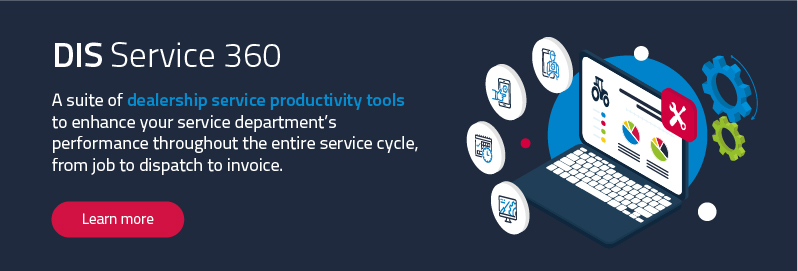
As technology evolves and reshapes the way we do business, it’s increasingly important for dealers to adapt and embrace digital tools to stay competitive. However, digital transformation is not just about incorporating new technology into existing processes – it’s about redesigning how we work.
To gain insight into this process, this blog post leverages insights from our webinar with MAC Advisor and Currie Management Consultant, Jim Henderson, on Digitally Transforming Your Service Office. We’ll explore what this process entails, what dealerships need to consider as they start their digital transformation journey, and how to emerge successfully on the other side of the transformation.
Click to Jump Ahead:
- Where can digital transformation happen in the service department?
- Where might a dealership go wrong in its digital transformation process?
- What does a successful digital transformation look like?
- What are some key goals of a digital transformation?
Where can digital transformation happen in the service department?
In the context of the service department, there are six levels of digital transformation.
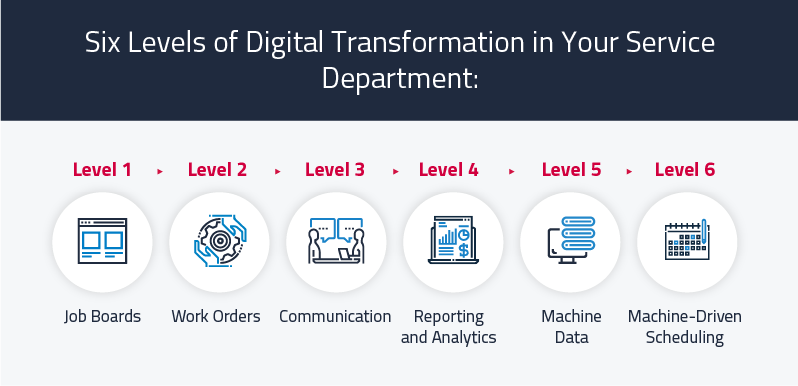
- The first level includes job boards where all open work orders are listed. Some service departments use a wall system with sticky notes to manage work orders, but digital software, like dealership management software, can help manage work orders through their entire service cycle.
- The second level entails work orders, which is the transition from paper-based to electronic work orders. This helps to reduce errors and increase the speed at which work orders are processed.
- The third level is communication, which involves moving away from traditional phone and email communication to more automated and real-time communication methods.
- The fourth level is reporting and analytics, which involves getting the information people want when they want it, both inside the dealership and outside to the customer.
- The fifth level is the use of machine data. That is, how do use machine data in our service department to automate and improve what we’re doing?
- The sixth level is machine-driven scheduling, such as when a machine needs preventative maintenance.
Read Next: 8 Ways to Implement Digital Changes in Your Dealership’s Service Department
Where might a dealership go wrong in its digital transformation process?
There are various factors that can lead to increased costs and difficulties for a dealership during the digital transformation process, including the following:
1. They work at the job description level – not at the process and task level
Successfully transformed dealerships have clearly mapped out their processes and understand the necessary steps or tasks involved in completing them. However, during the transition to digital, many aspects of the work can be taken for granted.
Experts may overlook important details that must be made explicit to effectively teach the process. It is similar to teaching a child how to tie their shoes – there may be many crucial details that are easy to forget but are necessary for successful learning.
2. “Common” undocumented knowledge

Undocumented knowledge or processes are those that are not written down anywhere but are instead solely in the minds of employees who know how to do them. This is a common occurrence in the industrial equipment industry, where workers often stay in the same job for a long time and accumulate significant knowledge over the years.
When transitioning to a new way of doing things, this undocumented knowledge can become crucial, but it may not be apparent until issues arise. Hence, having a plan and documentation in place to address roadblocks and find solutions is critical.
3. Not enough training and not enough time to adapt
The desire for quick results and cost-effectiveness can lead dealerships to overlook the need for extensive training when implementing new processes. However, training is not a one-time event, but rather a continuous learning process that enables employees to acquire higher levels of expertise.
For technicians, minimizing unbillable time is critical, but rushing them into new methods can actually lead to more lost time and money. Proper planning is needed to ensure adequate training is given. This may take more time initially but ultimately will result in greater efficiency and success.
4. No clear path to becoming the expert
Becoming an expert can be achieved through different paths. One approach is to work with vendors and super users who have expertise in the system. Another option is to concentrate on becoming an expert in your specific role and understanding how to efficiently do your job within the new system.
Whichever path you choose, it’s important to have a clear understanding of what it will take to reach your goals and plan accordingly.
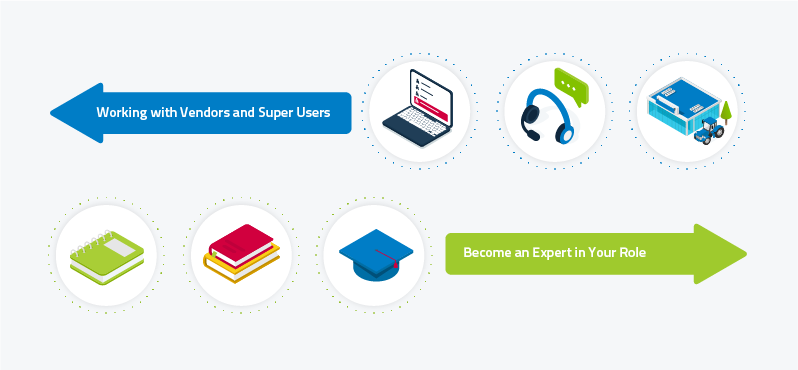
5. Cultural and daily work changes don’t happen in unison
To successfully transition to a digital system, companies must make both cultural and daily work changes. The culture change comes from the top down, and the company’s ability to manage and adapt to change is critical. Organizations that are not accustomed to change may find it difficult to navigate this process. However, starting with small steps and continually changing and learning to change can help.
In this way, both the culture and daily work must evolve together. By taking a gradual approach, embracing change, and encouraging innovation, dealerships can successfully navigate this cultural and daily work change to achieve a smooth and effective transformation to a digital system.
6. Failing to quickly address frustrations and concerns
When a company undergoes a significant change, it is common for uncertainties and concerns to arise. To address these issues, it is important to have a plan in place. One effective solution is to establish a system that provides employees with access to resources and support when they need it, either remotely or on-site.
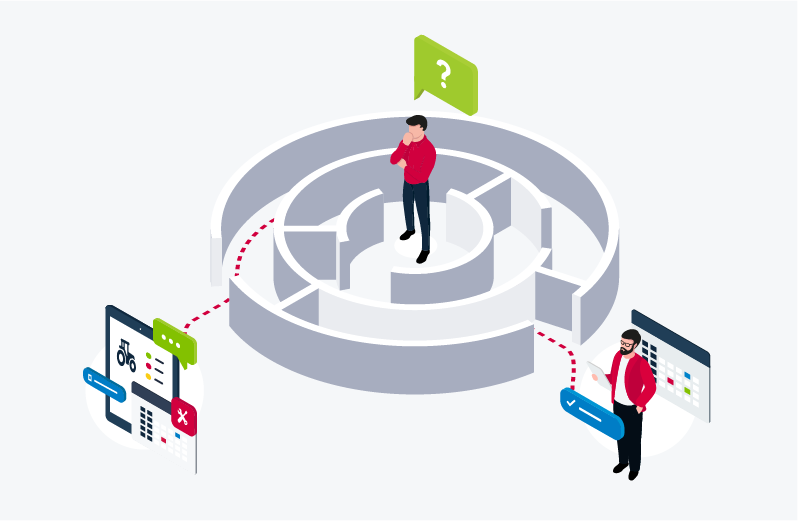
Assigning a designated person or team to answer questions and guide employees through the transformation can also alleviate stress and frustration. This support is particularly crucial in the early stages of the transformation when employees may not yet have the necessary knowledge and expertise to resolve issues independently. By prioritizing quick and effective support for employees, companies can help ensure a smoother digital transformation.
Read Next: How to Make Your Dealership’s Customer Service Ready for the Digital Future
What does a successful digital transformation look like?
Digital transformation can be a challenging process for employees, especially when it comes to their roles and responsibilities. Before the transformation, they feel like experts in their positions, but with new digital tools and processes, they suddenly become unsure of what to do and how to do it.
This is a common problem that happens during a digital transformation, and it is crucial to help employees feel like the experts they once were with the new digital tools and processes.
To achieve a successful digital transformation, you need to provide clear guidance and support to ensure that employees have the necessary skills and knowledge to complete their tasks effectively.

This entails an understanding and acknowledgment of the potential of digital tools and harnessing them to create a better future for everyone involved. Dealers need to plan for it and build projects around it to ensure its success.
A successful transformation can look like a work environment where employees can do their job well, customers are satisfied with the service, and the company can grow and generate more profit. Ultimately, the goal of the transformation is to benefit the employees, customers, and the dealership as a whole.
Measures of Success
Dealerships undertaking digital transformations do so because they want to enhance various aspects of their business, such as utilization, customer satisfaction, and first-time fix rate. These core measures do not change when transitioning from paper to digital, but the standard for these measures may be higher.
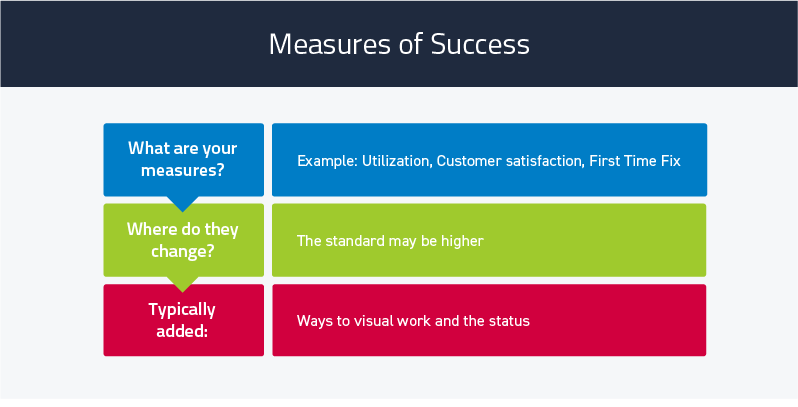
What is typically added in a digital transformation are ways to visualize work and the status of that work. For organizations accustomed to paper-based processes, the ability to visualize work and status becomes crucial to understanding what is happening and where they are. You need to make sure your teams and management can know how to quickly find the status of an item. Otherwise, it can become a point of frustration.
For example, a service coordinator is responsible for communication between the customer and the technicians. The service coordinator forms a digital diamond with the customer, technician, service management, and service office, who must all communicate and work together digitally.

When this diamond is functioning well, communication is faster, better, and everyone understands what’s happening. Everyone leverages the transformation to digital in a way that helps them all.
Read Next: Digital Tools to Help Transform Each Part of Your Dealership’s Service Department
What are some key goals of a digital transformation?
1. Customer Satisfaction
One of the key goals as you go digital is to drive higher customer satisfaction. This is particularly relevant as people become accustomed to services like Amazon, where they receive automatic updates about the status and location of their orders.
But in a lot of ways, people also want basic things, such as :
- Easily request service,
- Know the status of their requests,
- Be informed that what they expected to happen actually happened
These three measures are a good way of looking at the things that lead to satisfaction, and that can also be improved.
2. Profitability
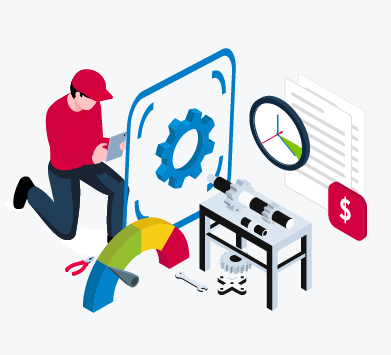
Another key goal is to drive higher profitability. Even with a digital transformation, the core measures of profitability remain the same. These include tech time on work orders, billing efficiency, and higher productivity.
Tech time on work orders is a crucial measure to have in place. It ensures technicians are working the full amount of time they are scheduled for. Billing efficiency is also important because it helps to reduce write-downs and ensures that jobs are being done efficiently.
Essentially, you want to know if the jobs are beating the standard or taking longer. It’s typically easier and better to get this data after a digital transformation.
3. Productivity
Higher productivity is a key measure in driving profitability.
The technician-to-office personnel ratio is a vital measure to track since it indicates how many technicians a company has for each person in the service office. The typical ratio today would be 1 office person for 5 technicians, but some dealerships have it as high as 1:12.
The aim is to keep pushing this ratio higher while maintaining satisfaction and efficiency.
Read Next: 10 Ways to Use Technology to Cope with the Technician Shortage
Keeping Your Eyes on the Digital Transformation Prize
As you embark on your digital transformation process, it’s important to have a clear understanding of what you want to achieve with the new processes. This means envisioning how the new processes will be different from the current ones and how they will improve the overall operations.
By having a clear goal in mind, you’ll be able to stay focused and motivated during the transformation process and ensure that you’re making progress toward your desired outcome. Monitoring your progress along the way and adjusting as needed will also help you stay on track.
In this way, you can be strategic and intentional in your transformation efforts and ensure that the changes have a meaningful and positive impact on your dealership.
